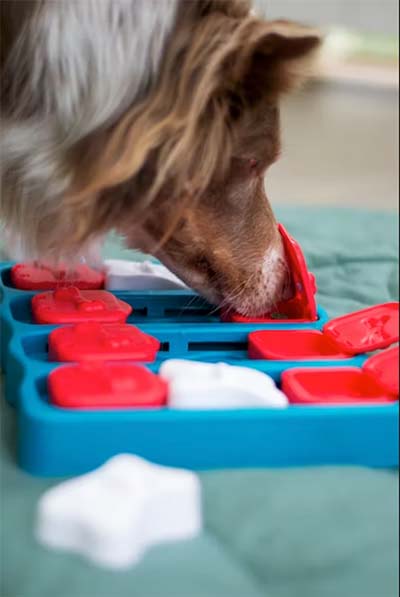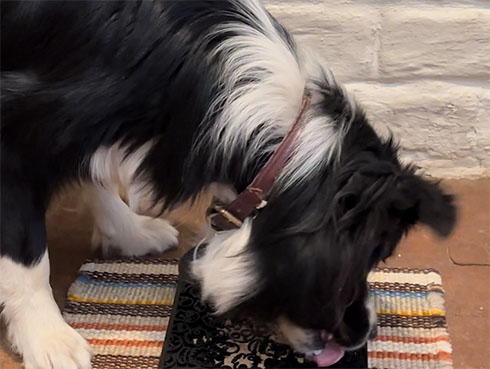Biting – Can You Ever Trust Again?

Folks like you and I are tethered to our pets by an emotional commitment to their well-being. If they have a problem with any body part, including their brains, we want them to get well fast. The Internet offers prodigious quantities of quack remedies, especially for behavior disorders. Think twice about quick and dirty corrections.
People do dumb stuff. Mistakes are part of life but ‘first do no harm’ should apply to everybody. Stimpy was a 3 year old terrier mix I saw for his worsening aggression toward visitors. He wasn’t always that way. He had been only nervous when guests breezed through the door but when one well-intentioned pet lover rushed toward him with arms outstretched, singing his name, the poor guy ran under the bed and trembled like a leaf. Amy, Stimpy’s devoted person, was advised to “socialize” her dog by exposing him to as many strangers as possible. She hauled him to pet supply and home improvement stores so she could invite shoppers to approach him for petting and treats. He tried to get smaller every time.
Then came the turning point. As a visitor stood and headed for the door Stimpy raced up behind him, nipping at his ankles. Well, that was unacceptable. Intent on putting an immediate end to this juvenile delinquent’s insolence, our friend, who “knows” dogs, grabbed Stimpy by the scruff, forced him to the floor, rolled him onto his back, and pinned him until he “submitted.”
OMG! I get it, sort of. We want our pets to reflect well on our character. The more this happened, the more embarrassing and frustrating it got for Amy. Stimpy’s dominance needed fixing right now, didn’t it? Well, that wasn’t the problem. And no, intimidation is not the answer.
Should we engage in pitched battles with man’s and woman’s best friends? Dogs are not our adversaries. They have no interest in winning a war for supremacy. We don’t need to take them down a few pegs and master their egos. We actually need to get a grip on our own.

Plucking Peace from the Jaws of Fear
Stimpy was alpha rolled and pinned to change his behavior but, call me crazy, I’ve never known bullying to help anyone get well. The disconnect for Amy and her visitor was believing that dogs need to be dominated to learn their rightful place as our subordinates.
Unbeknownst to these folks, as they swapped jokes on the couch, Stimpy’s dread had him hiding in the shadows.
His burst of bravado as he ran, snapping and growling at the heels of the departing visitor was not about him trying to be boss. When this big alien turned and walked away, the bottled up fear in that canine brain evaporated. Stimpy’s self-preservation immediately kicked in. With no path for retreat he was bent on creating distance from the scary monster by chasing him out the door.
It’s not that Stimpy was normal; his intense fear of strangers wasn’t at all healthy. He needed science-based behavior solutions to recover and enjoy a peaceful life. My job, in helping this human-canine duo turn disaster into success, relied on Amy’s empathy. She wasn’t genetically programmed to understand canine behavior because she wasn’t a dog but she was smarter than Stimpy. He would never catch on to human followership, no matter how much she wanted him to but she could learn canine leadership.
There would be no improvement from talking this out together, box of tissues at hand. It has been established that dogs and cats are capable of reason but they are not little people in furry suits. We let Stimpy be the dog he was hard-wired to be.
I taught Amy how to set her dog up for success. Rather than repeatedly thrusting him into a free-fall of panic with strangers approaching, leaning over, and reaching for him, we allowed the unhealthy neural circuits in his brain, those that carried his fear-based behavior, to weaken from disuse. Amy’s first job was to help her dog avoid his fear triggers.

Stimpy Avoided his Problems. Good Stimpy
Which of these statements is true? (a) Some dogs try to dominate their people and need us to keep them in line. (b) Dominance behavior among dogs happens but is sexual in nature. (c) It is a rare dog who tries to bully a human. (d) Alpha rolls work on dogs because they are innately knowledgeable in the Greek alphabet. (e) None of the above.
Stimpy, the former heel nipper, feared annihilation by anybody other than Amy. In his anxious mind, they could all be mass murderers. Nothing Amy tried made a difference. If anything, the problem had worsened.
The brain is considered the most complex organ in the body. Neuroplasticity – the ability to change its function and structure– can bring hope. As Stimpy repeatedly freaked-out toward unfamiliar people the responsible nerve pathways strengthened, leading to faster, stronger reactions. (Practice makes perfect.) On the other hand, if those unhealthy circuits were abandoned they could weaken from disuse. (If you don’t use it you lose it.) We wanted this for Stimpy.
Amy had believed that her wigged-out dog needed socialization but that process applies to immature canine brains, aged 7-12 weeks, when neural connections are still forming. That ship had sailed for grown-up Stimpy. He needed a break.
To help this boy gradually lose his stranger-danger mindset I told Amy to put him in another room, door closed, with a loaded food-toy before visitors arrived. If she delayed his feeding before these events he’d be hungry and motivated to engage his innate survival behavior of scavenging. At the same time, she could help him strengthen other brain pathways. Stimpy would hear the muted voices of Amy’s friends from elsewhere in the house but he’d be busy fiendishly extracting food.
His good leader’s job was to repeat this ritual every time she had guests. Stimpy no longer regarded them as threats. Instead he very gradually developed a positive association with hearing folks nearby. Food always happened.
The correct answer is (c). (If you got it wrong, it’s OK. I won’t breathe a word.)

Aggression Gone. What did Stimpy Learn?
Fear is a miserable emotion. It happens in-the-moment, before anybody has time to think. And it can be dangerous. Whether a threat is real or imagined you need to either get the heck outa there or drive off a scary monster – who might retaliate.
Stimpy had trembled and hidden from visitors, but later chased those beasts while snapping at their heels. With Amy’s gentle care, and my instructions, this good boy improved. While Amy entertained guests, he stayed busy in the other room extracting bits of sustenance from challenging food toys and puzzles. Not bad.
Amy now wanted Stimpy by her side as she swilled red wine with her pals. Was she dreaming? But if he could stay occupied… We knew that if he eyeballed another alien invader (anyone other than Amy) he could wig-out and relapse. She needed to keep him working.
So I told Amy, that social butterfly, to continue squirrelling her hungry dog away in the bedroom with a food toy prior to her friends arriving. After everybody was seated, settled, and focused on their Cabernet she would bring Stimpy out on-leash to find – a “lick mat” next to her chair, smeared with whatever this natural scavenger could not resist. Dogs will labor for extended periods, focusing on the narrow food-packed grooves, to reach every bit of liver pâte, peanut butter, canned food or whatever. And when they’re done, they are tired.
I also schooled Amy in teaching Stimpy to touch his nose to a target stick, which earned him an immediate click and a treat. Anytime he appeared tense or vigilant she would extend her Clik Stik ©, tell Stimpy “Target,” and then reinforce him with a click and a tidbit. Many species have learned to cooperate with humans, earning clicks and tasty morsels.
Research-based behavior modification was certainly helpful but Stimpy’s improvement began with his leader; he needed her empathy in order to succeed. He’s more peaceful now but he’s still not the party animal Amy had hoped would amuse her pals with parlor tricks. Actually, they were impressed with his targeting skills but they were inspired by Amy’s kindness.

